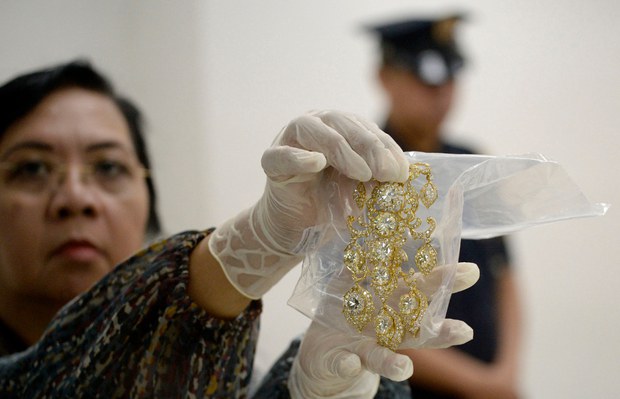Philippines: Duterte Approves Auction of Seized Marcos Jewelry
2019.06.04
Manila and Cotabato, Philippines
 An official from the Presidential Commission on Good Government shows a diamond-studded jewelry seized by the Philippine government from former first lady Imelda Marcos, at the Central Bank headquarters in Manila, Nov. 24, 2015.
An official from the Presidential Commission on Good Government shows a diamond-studded jewelry seized by the Philippine government from former first lady Imelda Marcos, at the Central Bank headquarters in Manila, Nov. 24, 2015.
The Philippine government said Tuesday it would auction off jewelry worth millions of dollars seized 33 years ago from Imelda Marcos, whose late husband was toppled in an army-backed “people power” uprising in 1986.
But the Marcos family, a political patron of President Rodrigo Duterte, would be allowed to participate in the auction, presidential spokesman Salvador Panelo said, sparking protests from victims of rights abuses under the Marcos dictatorship.
The jewelry collection, valued at more than $21 million (more than a billion pesos) when it was last appraised by international auction houses in 2015, includes rare Burmese rubies, Colombian emeralds and a 25-carat pink diamond estimated to be worth $5 million.
Duterte had ordered the Presidential Commission on Good Government (PCGG) to carry out the sale of the jewels, which are locked in a vault at the country’s central bank, according to Salvador Medialdea, Duterte’s executive secretary.
“An order was already issued by the president yesterday for disposition of the Marcos jewelry collection,” Medialdea told reporters.
Panelo said that the sale of the jewels would “benefit the public,” adding that there’s no law barring the Marcoses from joining in the auction.
He said the government would block moves from lawyers of the Marcoses to prevent the auction of jewelries.
“If they do, then we will oppose it because that’s the right thing to do. We feel that, as the president says, the proceeds have to go to the Filipino people who are in urgent need of government aid," he said. “Only the courts can stop the sale.”
Marcos, 89, was known for her extravagance. After she and her husband fled the presidential palace following two decades in power, authorities found her collection of thousands of pairs of unworn size-8 designer shoes at her bedroom’s basement.
She had also amassed paintings from masters such as Picasso and Vincent van Gogh.
In November last year, a Philippine court found Marcos guilty of graft, sentencing her to serve 6 to 11 years in prison for each of the seven counts of violations of an anti-corruption law when she illegally diverted about $200 million to Swiss foundations when she was governor of metropolitan Manila in the 1970s.
She was granted bail after convincing the court she first learned of her jail sentence on television news on the same day.
![190604-PH-Marcos-jewelry-INSIDE1.jpg Former political prisoners and human rights activists stage demonstrations in front of an anti-graft court in Manila to demand the immediate arrest of Imelda Marcos, Nov. 13, 2018. [Luis Liwanag/BenarNews]](/english/news/philippine/philippines-rights-06042019124109.html/190604-PH-Marcos-jewelry-INSIDE1.jpg/@@images/32ce6949-008e-451a-a7f7-1a6d2db22cbf.jpeg)
Brutal dictatorship
Danilo dela Fuente, an official of Selda, a group of human rights victims, said any proceeds from the auction should go to their members and others who had suffered under the brutal dictatorship of Ferdinand Marcos.
“While the Marcos family and the Duterte government cannot deny anymore that there are billions of pesos worth of ill-gotten wealth by the Marcos dictatorship, the question now is how do we make sure that this benefits the Filipino people,” dela Fuente said in a statement.
Thousands of students, activists, journalists and politicians were jailed and tortured during the Marcos regime, considered the darkest years in the Philippines’ recent history. Others went missing and were believed killed.
Authorities said Marcos plundered state coffers of up to $10 billion. Only a fraction of that money deposited in Swiss banks, as well as some properties linked to the Marcos family in the United States have so far been recovered.
Marcos died in Hawaii in 1989, three years after hundreds of thousands of Filipinos poured on to Manila’s main avenue in a near peaceful revolt that eventually sent him into exile.
His widow, Imelda, and their children were later allowed to return home. Marcos’ eldest daughter, Imee, in May won a seat in the Senate, running as an ally of Duterte.
Last month, more than 6,000 victims of human rights abuses committed during the dictatorship each received U.S. $1,500 as a result of a class-action lawsuit against the estate of the former Philippine leader. American officials allocated the money from the sale of an estimated $20 million worth of ill-gotten assets recovered and seized in the United States.
Dela Fuente said that many victims of rights abuses have died or are already old, but have yet to receive reparation for their sufferings, despite a recent order by a U.S. court that they should be paid out of the Marcos estate.
“They come from the poor and underprivileged, from faraway provinces who do not have access to the reparation process for rights victims,” he said. “They deserve to benefit from these funds. Not doing so defeats the purpose of recovering all ill-gotten wealth from the Marcoses.”
![190604-PH-Marcos-jewelry-INSIDE2.jpg Former Philippine first lady Imelda Marcos is photographed wearing jewelry adorned with rubies and diamonds during her 70th birthday party at a luxury hotel in Manila, July 2, 1999. [AP]](/english/news/philippine/philippines-rights-06042019124109.html/190604-PH-Marcos-jewelry-INSIDE2.jpg/@@images/ae20fad9-4c1d-4396-b817-79865b01ea1c.jpeg)







